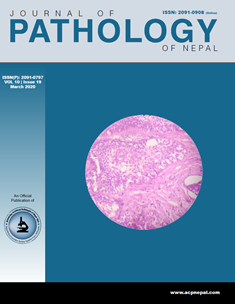A radical shift in the diagnostic approach to diffuse gliomas
DOI:
https://doi.org/10.3126/jpn.v10i1.28947Keywords:
Gliomas; IDH; 1p/19q-codeletion;Abstract
Astrocytic tumours comprise the majority of central nervous system tumours and they have been traditionally graded as recommended by World Health Organization on the basis of atypia, mitoses, microvascular proliferation and necrosis. The 2016 WHO classification of diffuse gliomas incorporates both molecular and histological criteria to categorize these tumours to better predict behavior. A layered diagnostic format is now the recommended approach with the WHO grade being assigned on histological criteria to be supplemented by molecular characterization once the result of isocitrate dehydrogenase is available. The presence of 1p/19q-codeletion has now been included in the definition of oligodendrogliomas. Oligoastrocytomas have now almost vanished as an entity because they are classified as either astrocytomas or oligodendrogliomas after molecular testing. Tests have to be modified in resource limited settings to reach a molecular diagnosis based on new scientific literature and research.
Downloads
Downloads
Published
How to Cite
Issue
Section
License
This license enables reusers to distribute, remix, adapt, and build upon the material in any medium or format, so long as attribution is given to the creator. The license allows for commercial use.




